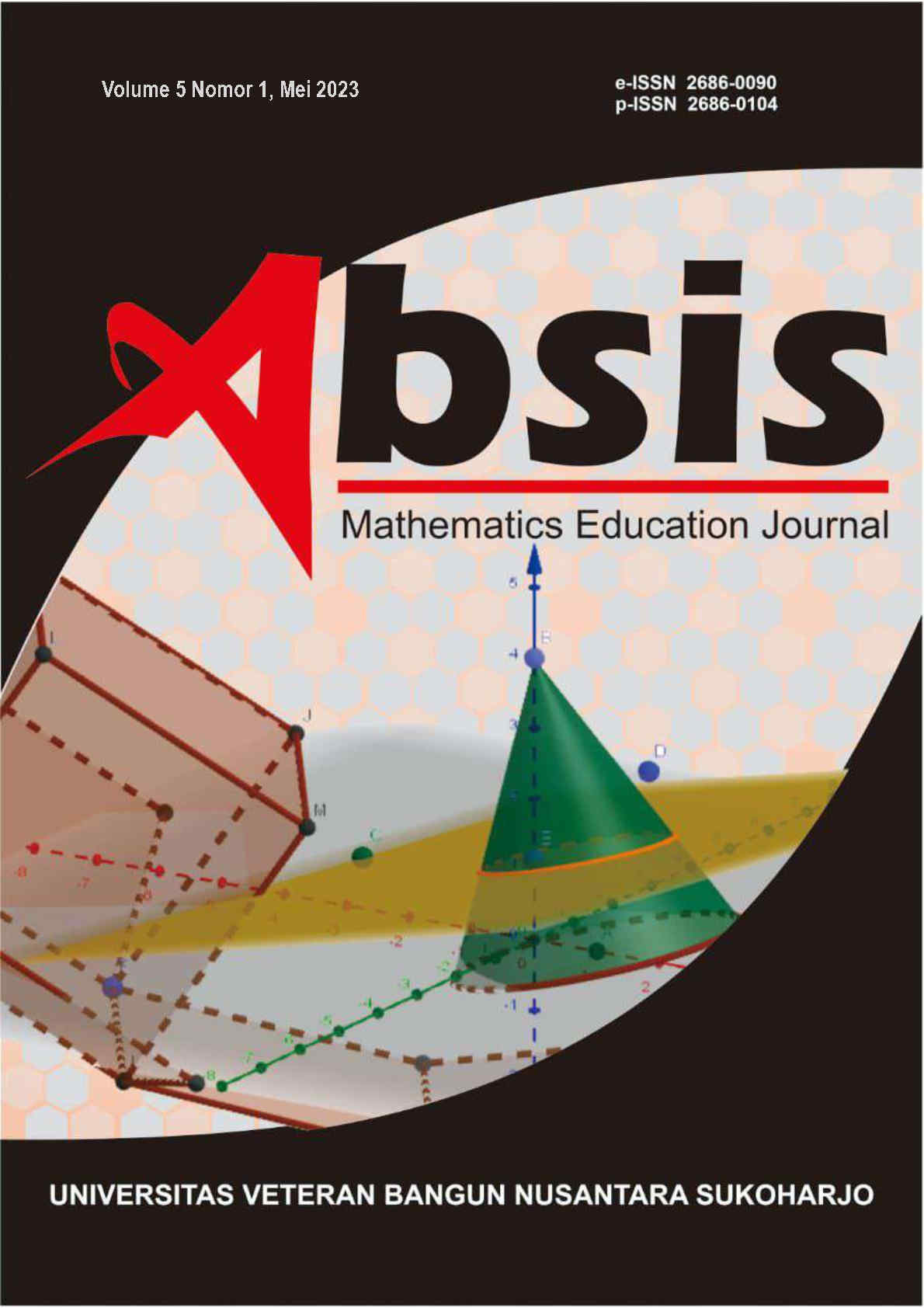Pengaruh Model Pembelajaran Pair Check terhadap Kemampuan Koneksi Matematis Siswa Kelas X MAN 1 Banyumas
DOI:
https://doi.org/10.32585/absis.v5i1.3511Keywords:
Pair Check Learning Model, Mathematical Connection abilityAbstract
This research aims to determine the influence of the pair check learning model on the mathematical connection ability of class X MAN 1 Banyumas students. This study falls under the category of quasi-experimental design research. Four hundred seventy-six students in class X MAN 1 at Banyumas served as the study's population. The sampling method employs a straightforward random sampling technique, in which samples are drawn randomly from the population without regard to their position. The two most notable classes from this research are X-2, which has 38 students and serves as an experimental school, and X-4, which has 38 students and serves as a control school. Instruments in the form of test questions were used to gauge participants' proficiency with mathematical connections. The data analysis technique using the N-Gain test showed a difference in the average N-Gain in the experimental class, which was 0.4727 more than the control class N-Gain value of 0.2354. Accordingly, it can be inferred that class X MAN 1 Banyumas' ability to make mathematical connections is impacted by the application of the pair check learning model.
Downloads
References
Aprilianti, A., Fani, D., Nia, K., & Effendi, S. (2021). Kemampuan koneksi matematis siswa ditinjau dari kecemasan belajar pada siswa smp pada materi lingkaran. 4(1), 137–148. https://doi.org/10.22460/jpmi.v4i1.137-148.
Azmi Rizky Anisa , Ala Aprila Ipungkarti , dan Kayla Nur Saffanah. 2021. Pengaruh Kurangnya Literasi serta Kemampuan dalam Berpikir Kritis yang Masih Rendah dalam Pendidikan di Indonesia. 1(1). paper 006.
Debby Yuniar, dan Lismi Rizki Lisayaroh. 2018. Kajian Kemampuan Koneksi Matematik Dengan Pendekatan Contextual Teaching And Learning Siswa Sma Pada Materi SPLDV. 2(1), 134-142. article.php (kemdikbud.go.id).
Habitati. (2017). Strategi Belajar Mengajar. Syiah Kuala University Press.
Hadi, S., & Umi Kasum, M. (2015). Pemahaman Konsep Matematika Siswa SMP Melalui Penerapan Model Pembelajaran Kooperatif Tipe Memeriksa Berpasangan (Pair Checks). EDU-MAT:.Jurnal..Pendidikan..Matematika,3(1),59–66. https://doi.org/10.20527/edumat.v3i1.630
Hafriani..(2021)..mengembangkan kemampuan dasar siswa berdasarkan NCTM melalui tugas terstruktur dengan menggunakan ICT. 22(1), 63–80.
Heris Hendriana, Euis Rohaeti, dan U. S. (2018). Hard Skills dan Soft Skills Matematis Siswa. PT Refika Aditama.
Karunia eka lestari dan mokhammad ridwan yudhanegara. (2015). PENELITIAN PENDIDIKAN MATEMATIKA. PT refika aditama.
Melani, A. E. T., Candiasa, I. M., & Hartawan, I. G. N. Y. (2019). Pengaruh Penerapan Model Pembelajaran Pair Check Terhadap Kemampuan Numerik Siswa Kelas Vii Smp Negeri 3Gianyar. Jurnal Pendidikan Matematika Undiksha, 10(1), 1. https://doi.org/10.23887/jjpm.v10i1.19900
Moch. Agus Krisno Budiyanto. (2016). Sintaks 45 Metode Pembelajaran dalam Student Centered Learning (SCL). UMM Press.
Moh. saiful Bakhril, Kartono, D. (2019). Kemampuan Koneksi Matematis Siswa Melalui Model Pembelajaran Peer Tutoring Cooperative Learning. PRISMA 2, 754–758.
Nasution, M., & Pd, M. (2018). Konsep Standar proses dalam pembelajaran matematika. 06, 120–138.
Permatasari, R., & Nuraeni, R. (2021). PLUSMINUS : Jurnal Pendidikan Matematika Kesulitan Belajar Siswa SMP mengenai Kemampuan Koneksi Matematis pada Materi Statistika. Jurnal Pendidikan Matematika, 1(1), 145–156.
Rostina Sundayana. (2018). Statistika Penelitian Pendidikan. ALFABETA, cv.
Siregar, E. F. S., & Sari, S. P. (2012). Pengaruh Model Pair Checks Terhadap Komunikasi. Jurnal Tematik, 10(2), 69–73. https://jurnal.unimed.ac.id/2012/index.php/tematik/article/view/19586
Stephanie Balqis. (2021). Pengaruh Model Pembelajaran Pair Check Terhadap Kemampuan Numerik Dan Self Efficacy. Skripsi UIN Raden Intan Lampung.
Surani, D. (2018). Pengaruh Pembelajaran Kooperatif Tipe Pair Check Terhadap Kemampuan Pemecahan Masalah Matematika Ditinjau Dari Kemampuan Peserta Didik Kelas VII SMPN 1 Sidomulyo”. UIN Radden Intan Lampung.
Downloads
Published
How to Cite
Issue
Section
License
Authors who publish with the Absis: Mathematics Education Journal agree to the following terms:
- Authors retain copyright and grant the journal the right of first publication with the work simultaneously licensed under a Creative Commons Attribution License (CC BY-SA 4.0) that allows others to share the work with an acknowledgment of the work's authorship and initial publication in this journal.
- Authors are able to enter into separate, additional contractual arrangements for the non-exclusive distribution of the journal's published version of the work (e.g., post it to an institutional repository or publish it in a book), with an acknowledgment of its initial publication in this journal.
- Authors are permitted and encouraged to post their work online (e.g., in institutional repositories or on their website) prior to and during the submission process, as it can lead to productive exchanges, as well as earlier and greater citation of published work.







